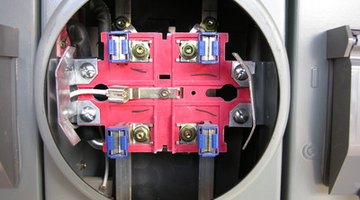What Is a Meter Base?
A meter base is a mounting plate for an electric watt-hour meter, the device that measures how much electricity a home or business consumed during each utility-service billing period. A meter base consists of a grounded backplate holding mounting lugs for the electric meter. One set of lugs connects to the electric utility mains, the other set to the customer's wiring. The lugs are arranged so that electricity must pass through the meter to get from the utility mains to the customer premises. The meter base is set in a weather-tight metal enclosure that’s sealed to prevent meter tampering.

Base Design Standardized
Up until 1934, watt-hour meter manufacturers gave little thought to consistency of meter mountings. This meant replacing an electric meter often required utility workers to rewire the service entrance for a new meter mount. According to the antique electrical equipment collector website WatthourMeters.com, a committee made up of representatives from the major meter makers and the larger electric utilities was formed in 1934 to develop a standardized meter mounting system that remains in use in the U.S. to this day.
Meters Move Outdoors
Standardized mountings simplified meter change-outs in the field, making them a matter of pulling out the old meter and installing the new one in the meter base without having to do any rewiring, says WatthourMeters.com. The standardized weatherproof mounts, together with changes to the meter placement rules in the National Electrical Code, made it possible to move the electric meter outdoors where it could be read without entering the customer premises. In construction today, the owner of the customer premises is responsible for installing the meter base, while the utility is responsible for installing the meter.
Meter History
The first watt-hour meter with a recording dial appeared in 1889 to measure consumption of AC electricity. It was invented by Elihu Thompson of Fort Wayne, Ind., and proved to be an immediate commercial success, according to WatthourMeters.com. The electromechanical watt-hour meter underwent a series of design improvements over the next 80 years, reaching its final evolutionary step in 1969. The electromechanical watt-hour meter has remained essentially unchanged since then.
How Meters Work
Watt-hour meters consist of an induction motor that runs faster as electricity demand at the customer premises increases. The rotating disk of the induction motor is connected by a shaft and gears to a mechanical dial whose pointers advance in a precise ratio to the number of times the rotor disk turns. Utility workers read the dial to determine how much electricity was consumed since the last meter reading.
Electronic Meters
In the 1990s the major meter manufacturers introduced electronic watt-hour meters that had no moving parts and which could be read remotely, either by a wireless receiver or by sending consumption data to the utility over the power lines. But millions of the electromechanical meters remain in use across the country. Today, the four manufacturers of watt-hour meters--General Electric, Landis & Gyr, Itron and Elster--offer solid-state electronic meters.
Writer Bio
Herb Kirchhoff has more than three decades of hands-on experience as an avid garden hobbyist and home handyman. Since retiring from the news business in 2008, Kirchhoff takes care of a 12-acre rural Michigan lakefront property and applies his experience to his vegetable and flower gardens and home repair and renovation projects.
Photo Credits
- meter housing image by jimcox40 from Fotolia.com
- meter housing image by jimcox40 from Fotolia.com
More Articles



